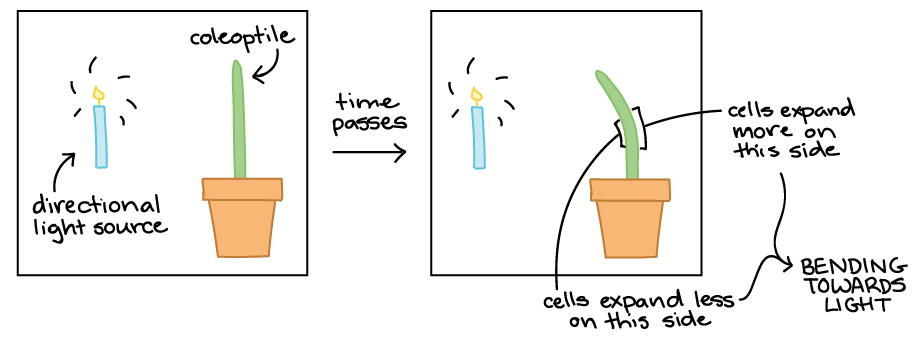This short lesson notes is all about plant movement, that it, plant coordination and control.
Plants need some internal coordination if growth and development is to proceed in an orderly manner with suitable response to their environment. However, plants do not posses a nervous system and rely entirely on chemical cooordination.As a result, their responses are slow and often involves growth.
For this quick or short notes, we will be focus on palnt movement and later on in another lesson notes, talk more about the ways in which pants activities are coordinated.
Movement in plants (plant movement)
It is a characteristic of plants that the whole organism doesn’t move. However, the movement of individual plant organs are possible and are modified by an external stimulus[1].
Movements caused by external stimuli include tow main categories namely;
- Tropism
- Taxes
- Nastic movement
Tropism or tropic movements
A Tropism is a movement of a plant part in response to and directed by and external stimulus. The movement is almost always a growth movement.
In other words, it is a biological phenomenon, indicating growth or turning movement of a biological organism, usually a plant, in response to an environmental stimulus. In tropisms, this response is dependent on the direction of the stimulus.[2]
This type of growth occurs when the cells in one area of a plant organ, such as a stem or root, grow more quickly than the cells in the opposite area. The differential growth of the cells directs the growth of the organ (stem, root, etc.)
Tropic movements are either positive or negative depending on wether the growth is towards or away from the stimulus respectively.
Types of tropism
There are many different types of tropic movements in plants. Below, we have some of the common types of tropic movements in pants;
Phototropism
This is a plant movement in resposnse to light. Phototropism is most often observed in plants, but can also occur in other organisms such as fungi. The cells on the plant that are farthest from the light have a chemical called auxin that reacts when phototropism occurs.
When the plant part moves away from the light stimulus, it is said to be negatively phototropic and vice versa.
Shoots of plants are postively phototropic whereas roots move away from light are a said to be negatively phototropic.

Geotropism
Geotropism is the movement of a plant part or organ in response to gravity. Some Fungi also exhibit this type of tropic movement.
It is a general feature of all higher and many lower plants as well as other organisms. A good example of a geotropic movement is exhibited by plant roots. Plat root moves in the direction of gravity and are said to be positively geotropic. As for shoots, they grow against gravitational forces and are therefore said to be negatively geotropic.
Chemotropism
Chemotropism involves plants movement in response to external chemical substances.
This type of movement is also observed in bacteria and fungi. A chemical gradient can influence the growth of the organism in a positive or negative way.
A positive chemotropism is one in which the growth response is towards the stimulus whereas a negative chemotropism is when the growth response is away from the stimulus.
Chemotropism can be observed during the growth of the pollen tube towards the ovules. Pollen tubes are therefore positively chemotropic.
Hydrotropism
This is a chemotropic response to water. Roots and pollen tubes are positively hydrotropic since they grow towards the direction where is water.
Aerotropism
This is also another type of chemotropic movement. Here, the growth is in response to air(mainly oxygen). The pollen tubes are negatively areotropic and this helps ensure contact between gametes.
Haptotropism or thigmotropism
This type of plant movement is owing to touch. That is, it is a plant movement in response to the stimulus of touch or solic surface. Tendrile and tentacles of plants are positively thigmotropic.




